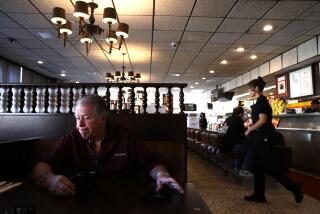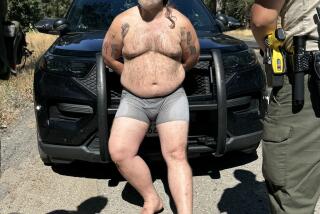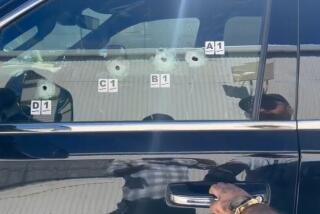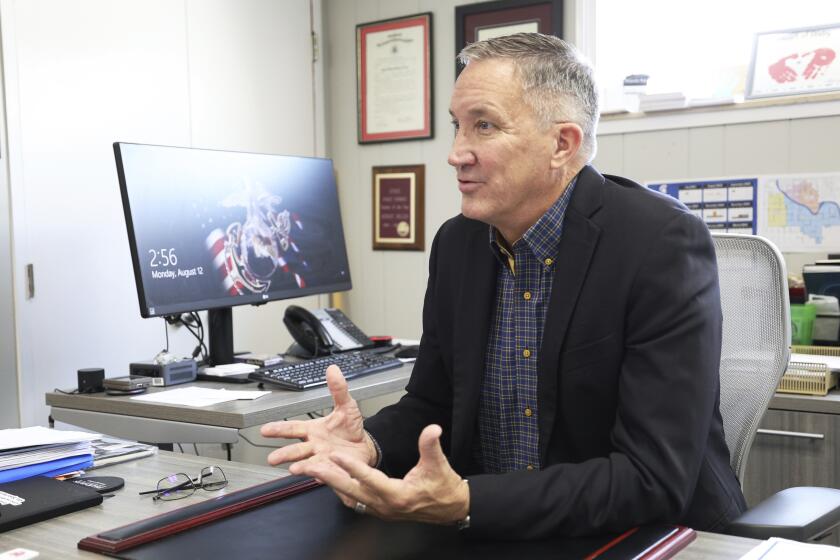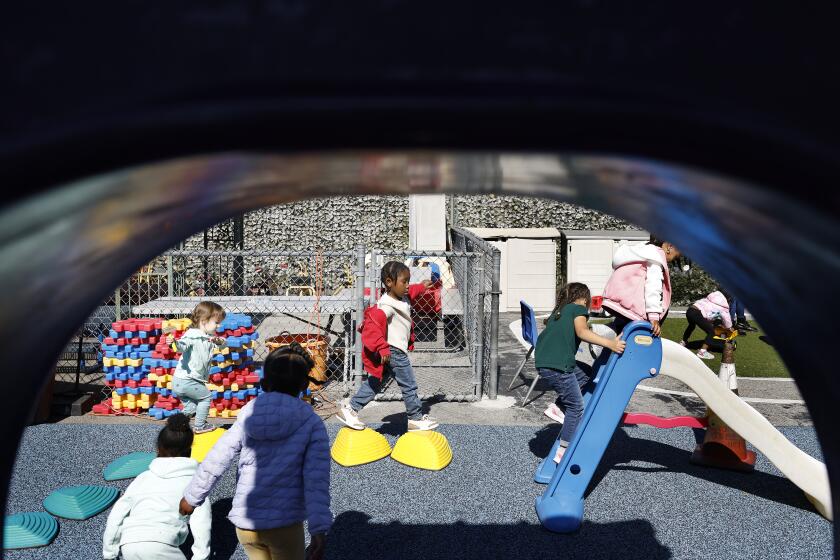Some Lessons That Hit Home Shake Up Science Instruction : Quake Experiments Follow New U.S. Standards
In lessons neither as dry as memorizing the periodic table of elements nor as distasteful as dissecting a frog, groups of students around Los Angeles are learning science through hands-on study of a phenomenon most have experienced firsthand: earthquakes.
In Carol Fink’s sixth-grade class at Nobel Middle School--so near the Northridge temblor’s epicenter that it is still undergoing repairs--students toppled wood block buildings on a recent morning by shifting sheets of construction paper buried under dirt.
For the record:
12:00 a.m. Feb. 1, 1995 For the Record
Los Angeles Times Wednesday February 1, 1995 Valley Edition Metro Part B Page 3 Column 5 No Desk 2 inches; 44 words Type of Material: Correction
Photo captions--Incorrect captions accompanied two photographs that appeared on page B7 (San Fernando Valley Edition) Tuesday. Pictured in the top photo were Renita Williams, Dan Masterman and Barbara Jackson working on a class project. The lower photo showed Michael Forrest and Tom Henyey addressing a class.
“Looks like Japan,” a couple of students yelled as the structures collapsed.
“And it looks like L.A. last year too,” Fink reminded them, segueing into a detailed discussion of the theory ofcontinental plate movement, known as plate tectonics.
It was just the sort of experiment and aftermath promoted by the new national science standards, which seek to transform science into a vibrant, fascinating subject aimed at preparing youngsters for an increasingly technological world.
No one has to persuade Los Angeles teachers of the value of hands-on instruction, especially for students who have a television-shortened attention span or who do not speak English well.
Yet they also know there are significant obstacles to bringing such innovations into the classroom, namely that most teachers lack the basic training and materials for hands-on lessons, especially at the elementary and middle-school levels emphasized in the national standards.
A draft of the standards, which aim to revolutionize science teaching, was released in December by the National Research Council. Because the guidelines include no government funding, the standards can only be met where state departments of education and individual school districts can find ways to reallocate existing resources or drum up outside donations.
“Unless there is support at the state and local level, the reform is not going to occur,” said Angelo Collins, director of the national science standards project.
In Fink’s case, both instruction and materials came from a special workshop coordinated through a private nonprofit organization funded by businesses and foundations: the Los Angeles Educational Partnership.
The workshop was part of a program known as Target Science, which is designed primarily for schools in the inner city--where teachers are generally less experienced--and which provides teacher seminars on subjects such as the Los Angeles River, wetlands and, this month, earthquakes.
“Hands-on works, and once you start, you can’t live without it,” said Mike Combs, who attended a recent quake workshop to glean ideas for his class at Bancroft Middle School near Hollywood. “But it’s hard with the budget cuts.”
Combs said he finds himself playing videotaped experiments in class because “if you can’t afford to let them do it, you can at least let them see it.”
But when students can actually touch the experiment, teachers say they learn more, especially in the earlier grades.
The morning after a Target Science workshop at USC’s earthquake center, enthusiastic teacher Nancy Soo used the heel of her hand to flatten clay onto a Manila folder cut into the S-curve of the San Andreas Fault. Encircled by first-graders from Rosemont Avenue School, Soo moved the folder halves in and out, up and down, as the clay formed peaks and valleys.
On the chalkboard next to her, Soo had written an essay about quakes and fault lines, which the first-graders had collectively dictated and would later copy onto composition paper with their fat pencils. It began: “Earthquakes are movements of the earth. . . .”
For Soo, hands-on teaching of science at the Echo Park-area school provides a perfect springboard for lessons in writing, in math, in history, in art.
“You can make science work for the whole curriculum,” she said.
When her students were asked what they had learned about quakes, their answers also ran that gamut. Seven-year-old Issac Walker said, “When they push, it makes mountains.” Six-year-old Yvette Alulema recited a more practical lesson: “I know you always go under tables, and not scream, and think.”
Teachers around Los Angeles have added and expanded lessons on quakes for a practical reason too: to combat their students’ fears.
“The more knowledge they have, the more understanding they have, the less scared they are,” said Mikee Bonar, who teaches fifth grade at Alexandria Avenue School near Downtown. Last year, Bonar included pictures of her severely damaged Northridge house in her lesson plan.
As is the case with all hands-on instruction, the key is to use the experiment or demonstration as an entree, capturing the students’ attention and then capitalizing on it with lectures, reading, discussion.
“What we are concerned with in the science standards is that students actually do inquiry, which means that they ask questions and that they seek things. . . . It’s hands on, minds on,” said Collins, of the National Research Council.
Or, as Bonar put it, “Once it’s cleared all away, you can say, ‘OK, what happened?’ ”
With younger children, that may take the form of a simple recap by the teacher: “You can see what happens when we have shaking under the ground during an earthquake,” Soo said, after completing the dirt-and-block experiment in her first-grade class.
With older students it may go much further, probing the unknowns of science instead of rote answers--one of the main goals of the new national standards.
In Fink’s class, 11-year-old Ian Wilson raised his hand for the eighth time and asked, “Has any scientist ever seen what a real plate looks like?” For Ian, the quake instruction is relevant because his family’s Reseda house jumped off its foundation last January.
His question provided the perfect opportunity for Fink to explain how scientists develop theories.
“They do see the proof and the scientific findings support it,” she said. “But they can’t actually see the whole plate. . . . We didn’t know about the fault the Northridge quake occurred on, so, you see, scientists know a lot, but they don’t know everything.”
Through Target Science, teachers learn directly from top scientific experts, strengthening their ability to answer students’ queries.
Comments made at an evening workshop by Tom Henyey, executive director of USC’s earthquake center, popped up two days later in Fink’s explanations to her students. For instance, she could tell them the exact distance California is compacting annually and explain that seismic activity is greater in Calfornia than in many other regions because two major plates are battling it out here.
Sometimes even the teachers are amazed by the results of hands-on science. Leslye Howell, another fifth-grade teacher at Alexandria Avenue School, said that after doing various demonstrations of plate movement, she was surprised when a student asked, “Does that mean the Pacific Ocean is getting smaller?”
“I nearly fainted,” she said, describing how she got out a map to illustrate that the Pacific is indeed shrinking, slowly. “Now I have 27 kids who want to be geologists.”
More on Science
* From the secrets of DNA to volcanoes on Venus, the TimesLink on-line service has a wide-ranging collection of articles on the sciences. Sign on and “jump” to keyword “science.”
Details on Times electronic services, B4
More to Read
Sign up for Essential California
The most important California stories and recommendations in your inbox every morning.
You may occasionally receive promotional content from the Los Angeles Times.
